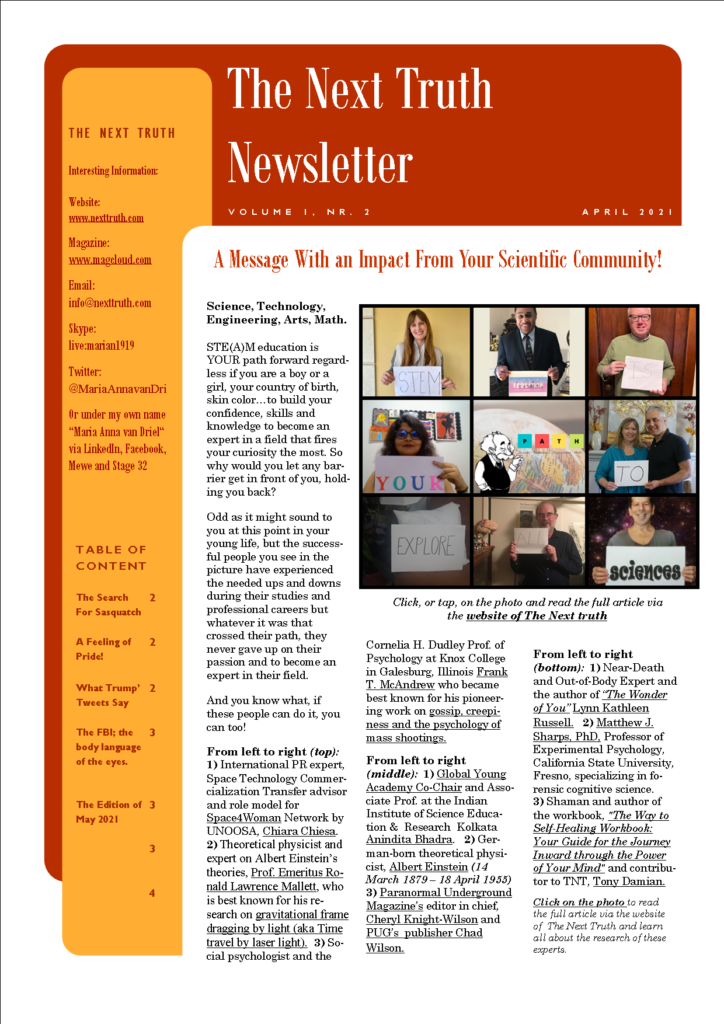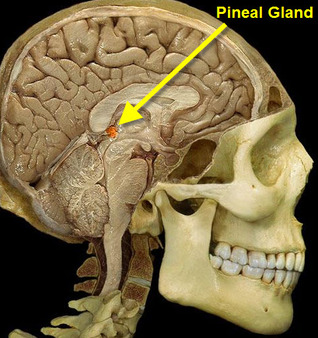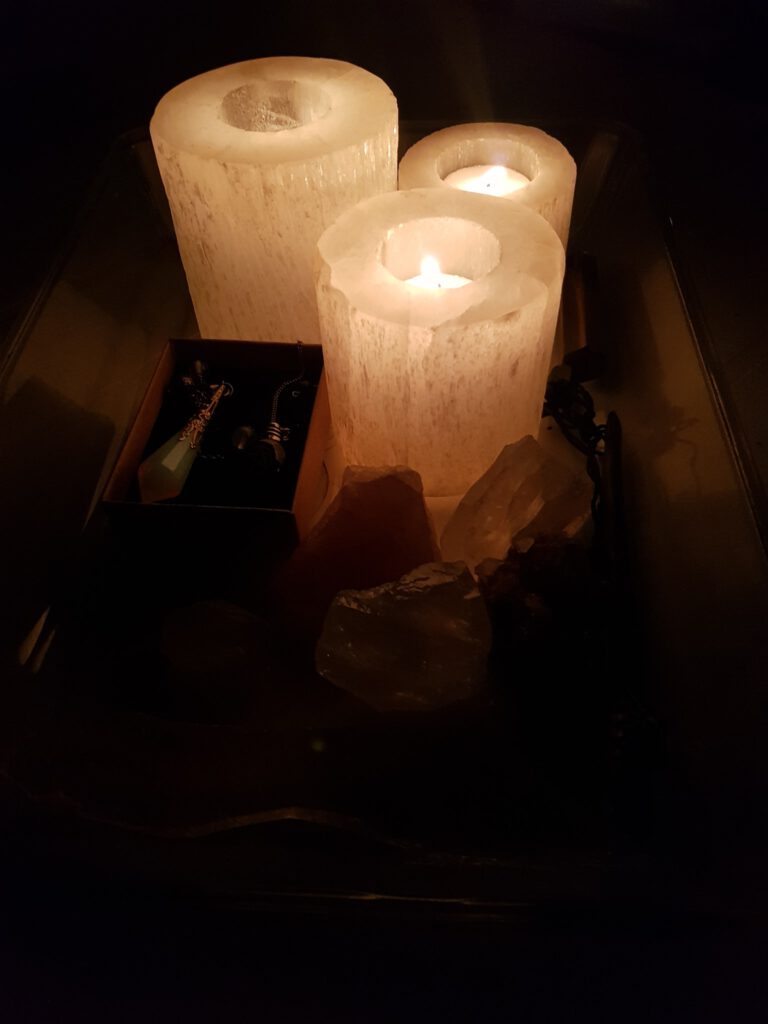The Physical and Biological Sciences Which Could Explain the Origin and Nature of Life in the Universe
An interview with SETI’s Senior Director of Education and STEM Programs, Dr. Simon Steel
Ever wondered what life on other planets would look like from a scientific perspective? Well, if you lived on a planet with twice the gravity of Earth, you would come crashing down twice as hard if you fell. So, some creatures would perhaps be stronger, stockier and with legs close to the ground.
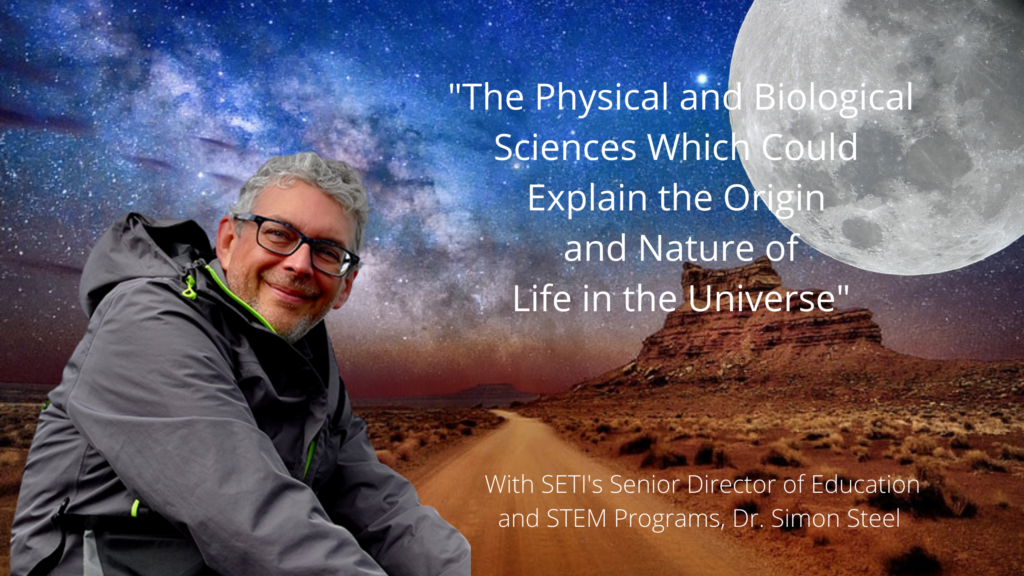
And what if there really were Martians? Well, Mars is a planet with low gravity so, think of creatures with thin, spindly legs. And if life evolved on a dense soupy planet then you could perhaps see creatures as big as whales or elephants flying not through air but, through a liquid atmosphere.
The humans species is not at the top of the evolutionary ladder. We are not the end point or the goal of evolution. Odd as it might sound to some but we where accidents. We eat and breath through our mouths and that means we can choke on food. That’s a terrible design! Maybe aliens evolved differently and don’t need to breathe through a mouth but, like worms do, through their skin. Anything is possible as long as it makes sense for the environment.
But how do we contact ‘them’ in this huge, vast universe and…what if we really do find complex life out there? Would it change our place in the universe because it is telling us that we are not alone?
I am your host Maria Anna van Driel… and you’re listening to “The Next Truth; Where Science and Myth Meet” and this week we are going to make an adventurous journey through the universe with SETI‘s Senior Director of Education and STEM Programs, Dr. Simon Steel. So, fasten your seatbelts, put on your space helmets, get rid of those outdated alien stereotypes and let’s explore our cosmic freezer like galactic detectives.
STE(A)M; A New Wave in a Vast Ocean of Possibilities.
By Maria anna van Driel, www.medium.com
Don’t wait until they tell you you are ready, get in there! If you, as a freshman, want to write, direct and star in your own vibrating career, the lights are already aimed at you.
That particular moment in where you know you have to deal with you’re not allowed to do that you know you have presented yourself in an incredible way and it’s only a ‘tough thing’ to convince people that there is something more or that they might want to see something different.
I have always believed that it is not about convincing others of you fitting the profile of their thinking but, that it is about an illuminated spark. It is about who you are as a person. It is about your soul reaching out to your true purpose in live.
What is the struggle worth? The ‘safe road’ is going pay off way better! Well, there are many payoffs to it but can you travel that familiar road and have your soul be on a completely different track…away from whatever it is that is truly firing up your passion and curiosity? It is always worth asking questions, explore new territory and, take a risk every now and then by, for instance, bringing new thoughts into your essay. And if this exploring side of you is not excepted by the, so called, popular kids in school, so what. You are expanding your mind, yourself!

You are the vanguard of knowledge and consciousness…a new wave in a vast ocean of possibilities.
On the other side of those school doors there is a world starving for new ideas and new leadership. And even though fear might be a player in your life sometimes, deciding how you can spend your whole life imagining ghosts and worrying about the pathway to the future, all there will ever be is what is happening here and the decisions you make in this moment for you to walk up to tomorrow. Decisions which are based on either love or fear.
As a teenager I had so many dreams of where I wanted to go, who I wanted to be and what I wanted to do. I wanted to be a brilliant engineer and build space ships, write scripts for Science Fiction movies and earn billions and billions of Euro’s. It might take a little time I thought but it will happen. What I didn’t want to think about was what do I have to start tomorrow. Then, 30 years later, completely unexpected, I was thrown into this expansive, incredible feeling of freedom. A freedom from myself – my problems – I saw that I was bigger then what my 18 year old version wanted to do. I was bigger than my body – I was everything and everyone.
I was no longer a fragment of the universe, I was the universe. And in that moment I realized that the purpose of my life was never about me walking the illuminated places the stage of life is presenting so sparkly. My true purpose in life had always been to free people from concern, to make them familiar again with their own define rhythm, for them to present their amazing work while walking the stage of life.
Realizing that my Ego was trying to keep me trapped in the multiplex of the mind, in this allay of ‘materialistic thinking’ eventually resulted in the expanding my thoughts. Today, 30 years later, this has reached a myriad people and created an incredible effect in them feeling comfortable…a view that is making me smile time and time again.
Too many people choose a path/career out of fear for what they really want, what seems impossibly out of reach or is too ridiculous to expect. So they never dare to take that step towards their true purpose in life, never dare to ask the universe for it. I am saying, you can fail at what you don’t want so, you might as well take a chance on doing what you love.
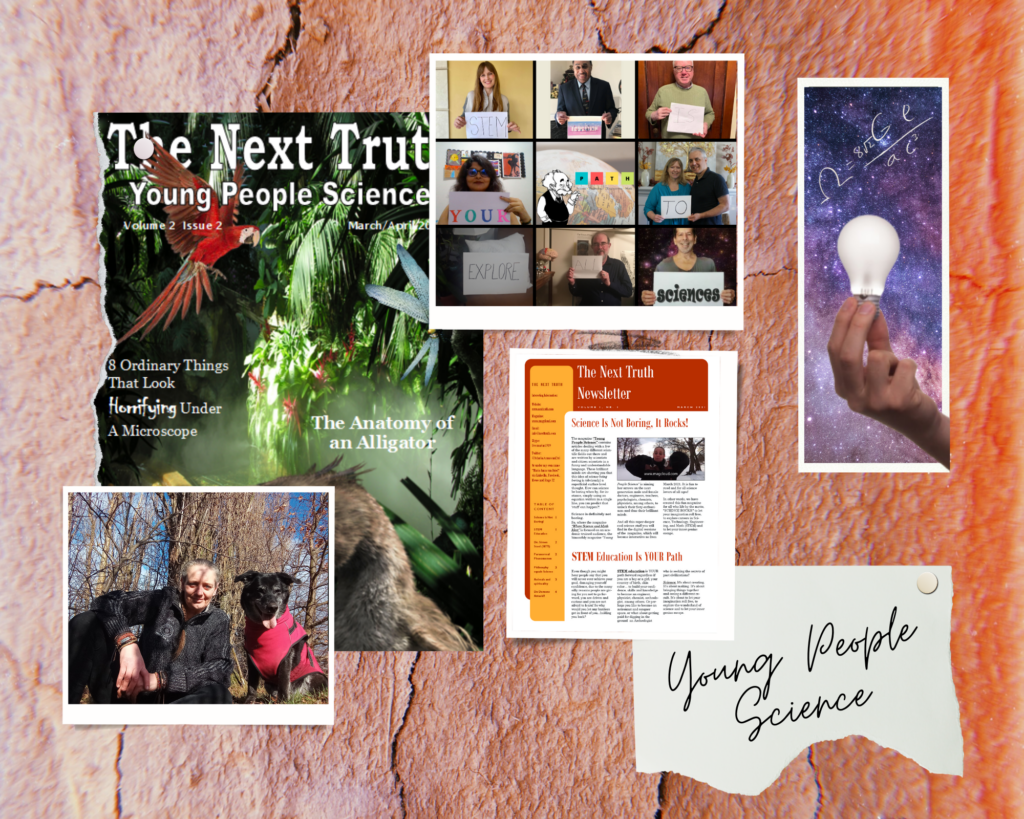
So, as soon as you start your favorite STE(A)M subject, your very first day at collage remember that your soul is not contained within the limits of your body, your body is contained within the limitlessness of your soul. And even if it might sound crazy to you at this moment, don’t search for defining moments because they will never come. These moments that define you have already happened and they will happen again.
And if you get a bit derailed along the way, that is alright…soon something starts to happen. A rhythm sets in just like it did after your first few days on the university. Just try not to wait, like me, until you are 48 before you find it, continue the one you have already found.
The world is yours!
[Top]Is Learning How to Expand Our Consciousness the Bridge to Build Between the Human Mind and AI?
For a long time, humans have wondered whether machines could eventually achieve consciousness or, whether artificial intelligence would ever reach a state of self-awareness.
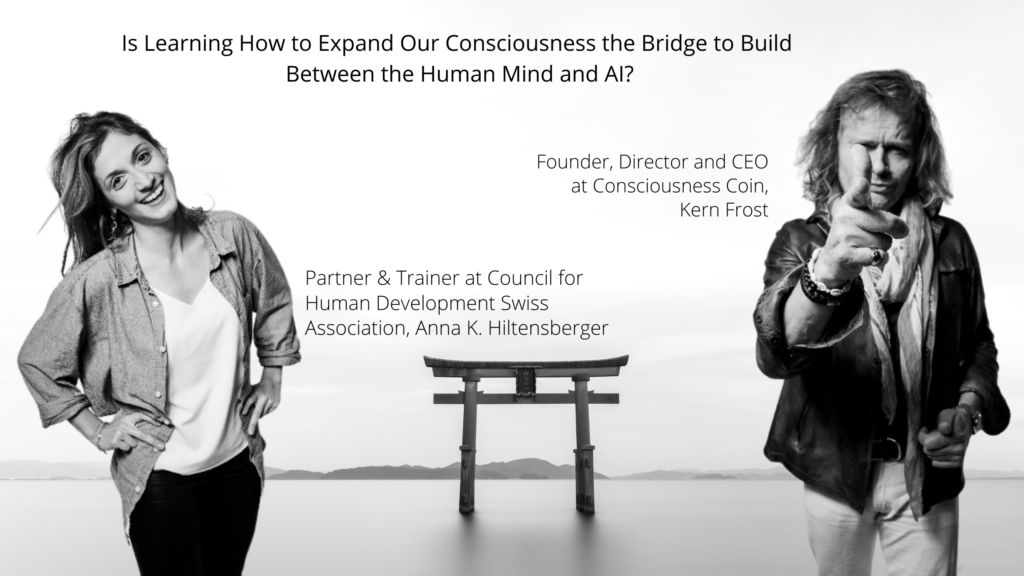
The exact definition of AI is hotly debated and there are already many fantastic explanations of AI on the internet but broadly speaking, AI is advanced statistics and applied mathematics which harnesses new advances in computing power and the explosion of available data to give computers new powers of inference, recognition, choice and, eventually, possessing an awareness of its own consciousness.
Will future AI really be able to do so?
Well, the first thing that is important to understand is that all that exists, whether seen or unseen, when it is broken down into its simplest and most basic form of energy, consists of a rate of frequency. To begin to comprehend the nature of Consciousness, and to directly experience an ‘Expanding Consciousness’ through increasing ones personal frequencies, one must go beyond flat linear thinking, thought addiction and stop accepting everything one has been told by others as fact and truth.
Will AI be able to train its own ‘mind’, step into the realm of direct cognition and higher sensory perceptual experiences what then allows it to perceive things as they really are and not what it, perhaps, wishes them to be?
I am your host Maria Anna van Driel… and you’re listening to “The Next Truth; Where Science and Myth Meet” and this week I am speaking with Partner & Trainer in accelerating thinking at Council for Human Development Swiss Association, Anna K. Hiltensberger and Founder, Director and CEO at Consciousness Coin, Kern Frost about how we can learn to expand our consciousness and if this is the future bridge to build between the human mind and AI?
[Top]A Message With an Impact From Your Scientific Community!
By Maria Anna van Driel, www.medium.com , edited by Cheryl Knight-Wilson
Life is a cruel system, is it not? Or should I say society is? As a young student, you work hard, really hard! For days, weeks, months…you put all your energy in your field/lab research, your calculations, or in finding the perfect words for your essay, thesis, book, article. During this period, you slowly start to see a fabulous outcome. Yes…you are going to ace this for sure! Proudly, you present the results of your hard work! And then, reality kicks in. People say your calculations are gibberish, you have researched in the wrong direction, and your book does not contain coherent grammar. SH*T!
Now you can throw all your notes out the window from the highest building you can find and crawl into a deep, dark cellar hiding yourself from the world and let this terrible feeling of disappointment consume you entirely. Okay, this sh*tty feeling is understandable, but do really think you have failed?

Well, the contributors of The Next Truth magazines have another thought on this that is backed up with both waterproof scientific evidence and years of life experience. And odd as it might sound to you at this point in your young life, but the successful people you see in this picture have experienced the needed ups and downs during their studies and professional careers. But whatever it was that crossed their paths, they never gave up on their passions and to become an expert in their fields.
And you know what, if these people can do it, you can too! So, when life knocks you down, try and land on your back, because if you can look up, you can get up. If you want a thing bad enough to go out and fight for, to work day and night for your passion, spent your time on making this your decade, you’ve got to start saying YES to your dreams and your unfolding future.
Believe it or not, you are going to be there one day, but you will never get there if you give up, if you give in and quit.
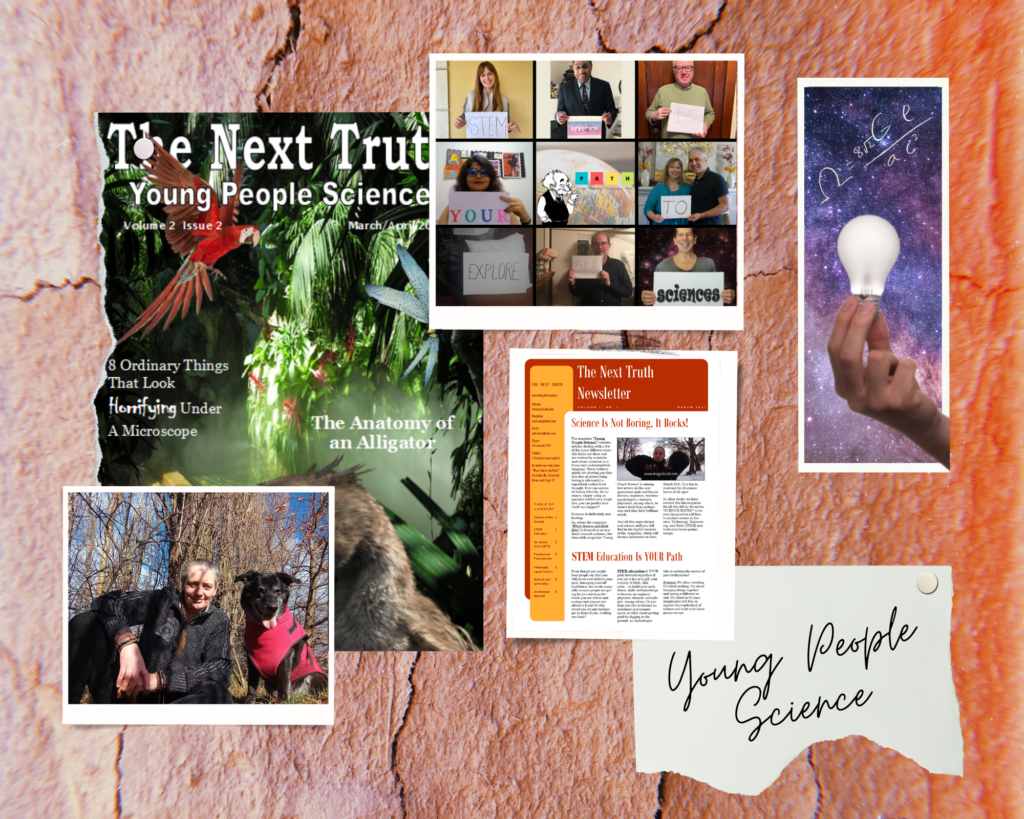
STEM education is YOUR path forward regardless if you are a boy or a girl, your country of birth, skin color…to build your confidence, skills, and knowledge to become an expert in a field that fires up your curiosity the most. So why would you let any barriers get in front of you and hold you back?
From left to right (top): 1) International PR & Space Technology Commercialization Transfer advisor and role model for Space4Woman Network by UNOOSA , Chiara Chiesa. 2) Theoretical physicist and expert on Albert Einstein’s theories, Prof. Emeritus Ronald Lawrence Mallett, who is best known for his research on gravitational frame dragging by light (aka Time travel by laser light). 3) Social psychologist and the Cornelia H. Dudley Prof. of Psychology at Knox College in Galesburg, Illinois, Frank T. McAndrew, who became best known for his pioneering work on gossip, creepiness and the psychology of mass shootings.
From left to right (middle): 1) Global Young Academy Co-Chair and Associate Professor at the Indian Institute of Science Education & Research Kolkata, Anindita Bhadra. 2) German-born theoretical physicist, Albert Einstein (14 March 1879 – 18 April 1955) 3) Paranormal Underground Magazine’s editor-in-chief, Cheryl Knight-Wilson and PUG’s publisher, Chad Wilson.
From left to right (bottom): 1) Near-Death and Out-of-Body Expert and the author of “The Wonder of You”, Lynn Kathleen Russell. 2) Matthew J. Sharps, PhD, Professor of Experimental Psychology, California State University, Fresno, specializing in forensic cognitive science. 3) Shaman and author of the workbook, “The Way to Self-Healing Workbook: Your Guide for the Journey Inward through the Power of Your Mind” and contributor to TNT, Tony Damian.
[Top]Think Before You Deny Young People to Explore Science!
Odd as it might sound to some but, if we deny young people, who are our next generation scientists, to explore UFO technologies we deny them to explore the science of engineering. If we deny them to search for Bigfoot, the creature of Loch Ness, we deny them enroll studies like Mythology.
If we deny their curious minds to find out if their is extraterrestrial life in the universe, we deny them to become an Astronomer, Astrophysicist, or perhaps to become an Astronaut. And if we teach young people that it is childish to play with dinosaurs, Anthropology and Biology will be wiped out from their curious minds. If we hold our future generation scientists back by telling them to stick with ‘thinking inside the box’, we will destroy the future philosophers.
STEM is not just a subject at school it’s a way of thinking and doing and an important skill set that could see your generation working together to solve some of the world’s greatest challenges.
Stem stands for Science, Technology, Engineering and Mathematics but it’s not about being an expert in all of those things, instead it’s about harnessing the essential transferable skills behind them.
Scientists know how to hypothesize experiment analyze and evaluate what they discover.
Technology can make our lives better designers of all sorts work together to make everyday tasks more effective and more fun.
Engineers don’t solvers that work on some of the world’s biggest challenges like creating bionic limbs for people with disabilities or exploring outer space.
Mathematics teaches us how to quantify data and how physics rules the world around us. With mathematics we can implement change and minimize error.
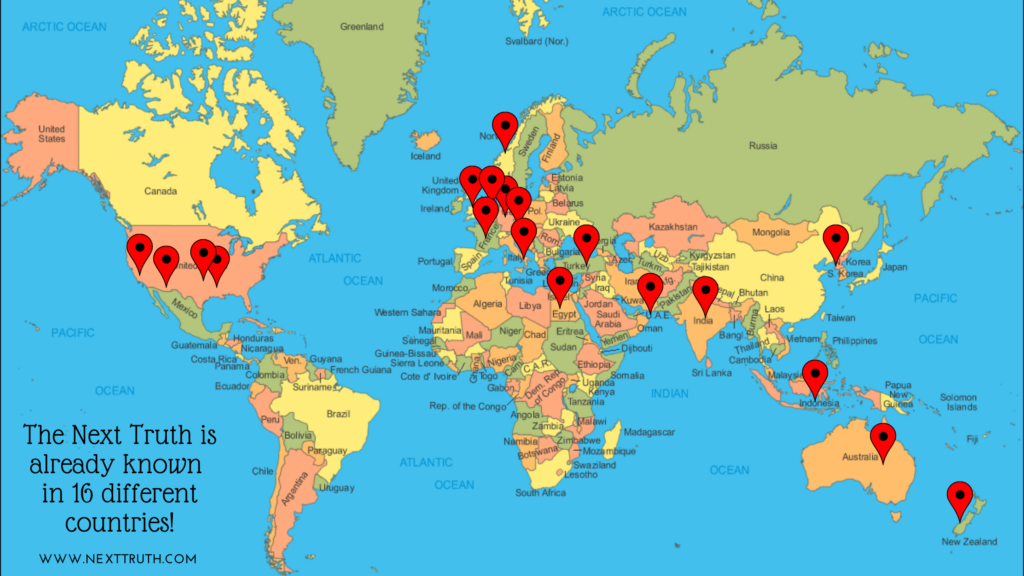
You won’t have to master all of these skills either. Teamwork is an essential STEM skill. Take the search for new energy sources for example. Geologists and geophysicists search for gas deposits. Engineers help you design and run platforms and processing plants Construction. teams work to build essential infrastructure under the supervision of project managers. And environmental scientists work with everyone every step of the way.
Plane to your strengths and working in a team will have you creating a greater impact than if you are working alone. It would cost the Australian economy 9.3 billion in lost productivity profitability and employee satisfaction.
STEM skills are useful to almost every career 75% of today’s fastest-growing careers require STEM skills and 82% of today’s employees say they value STEM skills even if they’re not required for the job. STEM skills can even unlock your potential to earn a higher salary or become more employable. You don’t have to earn a university degree in stem to be successful either. There are plenty of courses to get you started in stem but we don’t have enough stem graduates to meet demand.

Numbers show the demand for STEM careers has grown 79% since 1990 but enrollments in stem degrees are at an all-time low compared to the last 20 years. And despite the job opportunities just 16 of stem professionals are women.
STEM careers can start small then change the world. Engaging in your high school stem classes or learning to code could be your first step to delivering tribalist vehicles to the roads, starting a research project at home or entering a science competition could see you to feeding cancer with a cure.
And that’s just the beginning! We don’t yet know what kind of jobs will exist 10, 20, 30 years from now but with STEM you’re prepared for anything.
How will you shape the future with your stem skills?
Ghosts; Do They Hide in the Light?
By Maria Anna van Driel
A ghostly apparition walking through the wall, an odd shaped craft hovering in the sky or strong ripples on the surface of a lake indicating that there might be a sea monster swimming by… even though many people have seen and reported these rare but remarkable events, they do not have an explanation for what they have witnessed.
Are those, in the dark hiding, eerie shadows, truly disembodied humans who are lost or, is this an effect of Sleep Paralysis.
Is walking through a forest at night only scary because we are breathing in these, released by the trees, small amounts of methane gas while the pineal gland in your brain is detecting the ultra– and infra sound-waves are bouncing off on the trees after it has released by your own body? Or is there something malevolent hiding behind the shrubs, waiting for you to become its prey?!
Hum, that is indeed a fascinating question. So, let’s imagine that we are standing in a forest with trees all around us. Odd as it might sound but these trees have the ability of releasing a kind of resonance what can ‘communicate’ with your personal frequencies which can turn into that infamous fear frequency sending shivers down your spine.
Did you know that trees have the capability of releasing CH4, aka methane gas? A gas some say is one of the sources of today’s global warming.
Not only do trees poop Methane, they also contain liquid crystal in which a piezo-electrical effect can be observed when encountering an ambience of bright light or a heat (electrical) source. Both of these source is what you are carrying when walking a dark forest…your flash light and your body what is now electrical charged by means of the mind is entering a fight-or-flight state.
The small amounts of the odorless methane gas released by the trees around you might be just enough for you to see creepy plasma clouds forming containing photo-generated electrons which are brought together by a piezoelectric effect, dancing on the surface of natural piezoelectric (semi)conductors.
In neuroscience (or neurobiology) it is well known that the pineal gland becomes active, or is waking up so to speak, once its host is in a dark environment meaning, you being active during those hours of the day in where UV-light is not present in large amounts. Walking this darkness means that you can’t rely on your eyesight anymore what converts your body into a biological radar devise emitting sound-waves in order not to bump into anything or, to survive any dangerous situations heading your direction with high speed.
These ultra- and infra sound-waves your body is emitting, are bouncing off on the objects in your surrounding and, sometimes, have a behavior of returning back to you as a relativistic microwave and creating this chilling feeling of static electricity
You, now acting as a human radar devise, breathing small amounts of odorless methane gas as well as sensing the vibrations of the trees and returning microwaves, which are communicating with your brain, have resulted in a blood-curdling form of vivid hallucinations while it is being combined with a personal fear frequency based on creepy stories you once have read or watched via You Tube or Netflix.
Suddenly you are right in the middle of a spine-chilling situation what seems to be written by Alfred Hitchcock himself! This effect in sensing ‘things’ which seem to have no clear and visible source is based on inaudible to the ear sound-waves and chemical reactions and is one of the two ingredients of nature creating ghostly apparitions in a dark forest.
A second ingredient to create this blood-curdling effect falls in the range of an unnatural source. By means of an ambiance of LED light the liquid crystals inside the trees are triggered and create an effect of being elastic. Aka the expansion and shrinking of crystals what is giving them the ability to record and play vague but hearable sound effects and even create visible images.

Like a laser directed to a LP made of wood, LED-light can function similar to a laser, faint but not impossible.
Imagine walking through this dark forest while carrying a torch with LED-light … you will instantly understand which kind of effects this bright light source can create without your awareness. Being focused on, for instance, a paranormal investigation and not on the, seemingly, logical reactions when certain elements are being brought together, a creepy surrounding containing real ghostly effects has being created unintentional which can scare the hell out of you when it is combined with your personal fears.
I am wondering, what will be the effect seen, or sensed, when we are we adding an extra element to this natural event…a stressed cellular memory?
[Top]Sasquatch; Legend Meets Science
An interview with Idaho State University’s Professor of Anatomy and Anthropology, D. Jeffery Meldrum
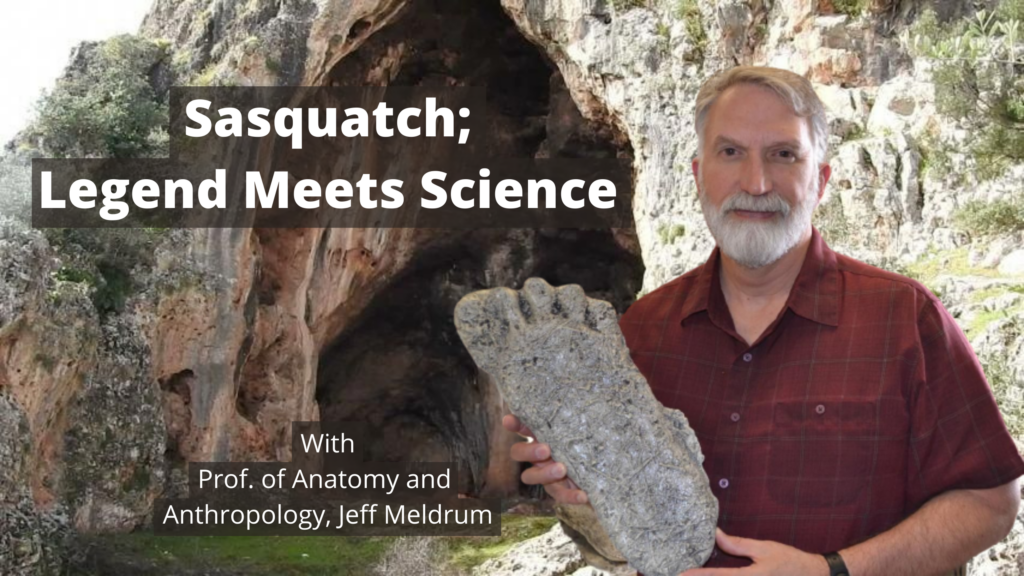
Every part of the world has its legends.
The Lakota believed in a powerful, burly figure they called “Chiye-Tanka”, or “Big Elder Brother”. The Eskimos called it “bushman”. The Colville Indians call him “Sasquatch” and the Hoopas of northern California call him “Omar”.
In 1604, French navigator Samuel de Champlain ominously described a frightful monster, what bears the name “Gougou”. In 1811, explorer David Thompson was hiking through the Rockies when he stumbled upon some seriously massive footprints, while an 1884 edition of a British Columbia newspaper called ‘The Daily Colonist’ reported the capture of a young, gorilla-like primate called “Jacko.” In 1924, a group of miners in Washington claimed to have been besieged all night long by a troop of hairy ape-man in a chasm now known as “Ape Canyon“.
Is it a bear? Could it possibly be some kind of giant ape? Could it even be some kind of ancient hominid, a member of the human family like Neanderthals that were thought to be extinct or…could it be a hoax.
Bigfoot, Yeti, sasquatch… It strikes fear and the imagination. Is it real or myth and why hasn’t anyone captured a Bigfoot. With all the leading technology scientists have today, why haven’t they found definitive evidence?
I am your host Maria Anna van Driel… and you’re listening to “The Next Truth; Where Science and Myth Meet” and this week I am speaking with Idaho State University‘s Professor of Anatomy and Anthropology, Jeff Meldrum about the science behind Bigfoot. Is there compelling evidence of Bigfoot being real.
[Top]The Future of Communication
In the digital age, technology is transforming how and what we communicate.
By guest writer Dr. Vyvyan Evans
The future is notoriously difficult to predict. For instance, in one scene from the cult classic sci-fi movie Blade Runner, the main character, Deckard, played by Harrison Ford, is in a bar. He makes a phone call to Rachel, with whom he’s falling in love, and invites her to join him for a drink. But while the future Los Angeles involves off-world colonies, cyborgs, or “replicants” as they are termed, and hover cars, Deckard places the call from a hard-wired “Vid” phone on the wall. Apparently, foreseeing the invention of mobile phones was a step too far for the 1982 movie.

Future tech and communication
Predicting the future is even thornier when considering human communication. From the perspective of technological innovation, we are living in a digital age: technology is transforming the ways we communicate with one another, and interact with the world around us. Meanwhile, other technological pipe dreams that were once only the preserve of science fiction are now becoming reality.
For instance, John Anderton, the character played by Tom Cruise in the 2002 movie Minority Report—originally a short story by Philip K. Dick, as was Blade Runner—wears a data glove, providing a sophisticated gesture-based interface system. But touch-based computing is now de rigueur, with the pinch, pull, and swipe features of Apple iPads and iPhones having led the way in the 2000s. In computer gaming, the Wii in 2006, and later, Microsoft Kinect consoles developed similar ways of interacting and controlling virtual characters and actions. Devices such as these are surely but a prelude of what is to come.
MIT computer scientist John Underkoffler predicted, in his 2010 TED talk, that virtual touch-based computing, à la Minority Report, is the future of human-computer interfaces; and at the time of writing, he is leading the development of an immersive human-computer interface environment that aims to fully replicate the science fiction of fully intuitive gesture-based systems.
Perhaps an even more exciting area of research, one that will transform how we communicate with computers over the longer term, is so-called brain-computer interfaces. In the 1995 film Johnny Mnemonic—a cyberpunk action thriller, based on the short story by William Gibson—the protagonist, played by Keanu Reeves, wears a cybernetic brain implant that stores information that can be extracted.

Today’s research on brain-computer interfaces works on a related idea: the brain makes use of electrical signals—an electrical code—to transmit and process information. For instance, sensory information, such as light and sound, harvested by the eyes and ears, is transduced into an electrical nerve impulse that the brain can process. Research on brain-computer interfaces works on the same principle—the idea is that as the brain runs on electrical signals, and assuming these can be accurately read, then the signals should allow us to communicate with external devices via the transmission of electrical impulses directly from the brain. For instance, it should be possible, at least in theory, to harness the brain signals that move your arm and hand to control a robotic arm to, say, pick up a cup of coffee.
Research of this kind is ongoing. It is already becoming possible for amputees to use prosthetic limbs with the aid of computer software; and the aim is to interpret the brain’s electric signals—to control action through thought. In research undertaken by the U.S. government’s Defense Advanced Research Projects Agency (DARPA), subjects who have lost limbs are now able to ‘feel’ sensations, due to electronic communication between ‘bionic’ prosthetics and the brain. This works by using microprocessors in the bionic limb to ‘complete’ the brain’s neural circuit. Outside such specialised research venues, cochlear implants, allowing the hard of hearing to hear, are currently the most widely available use for this technology. The principle enables brain signals to communicate with the implant, thereby overcoming the damaged part of the ear. In the future, it may be possible for implants in the brain to allow us to communicate directly with and control a wide array of devices, using the power of thought alone, as recently advocated by Elon Musk’s Neuralink project, which proposes embedding microchips into the human brain.
In terms of interpersonal communication, some of the earliest predictions about mobile or virtual communication have come true. The hand-held communicators used by Captain Kirk and Mr. Spock in the original 1970s episodes of Star Trek are essentially hands-free mobile devices, with Bluetooth earpieces. That said, contemporary mobile phones do, nevertheless, require earth-orbiting satellites; hence, their communication range does not encompass subspace transmission, and as such, is not intergalactic—just yet.
Computers and smartphones now come with fixed cameras as standard. This means that we can see the person we are talking to, in real time—media apps such as FaceTime and Skype are cases in point. The next step, perhaps, is the so-called telepresence robot. These are mobile units that host a camera and speaker that can be controlled remotely by someone whose voice and image can be projected. And the virtual person can not only see, via their remote camera, but also follow around and otherwise interact with the person with whom they are conversing. The scope for teleconferencing, and ‘remote’ tours of a specific venue, such as visiting a real-estate proposition, a new factory, or a construction site, are obvious. While today’s telepresence robots are not cheap, the cost is likely to come down and the systems will improve as the technology advances.
The Ratchet Effect
The rapidly changing face of communication is underpinned by what has been termed the ratchet effect. The idea is that culture provides a complex network of shared knowledge, systems, behaviours, and practices. This means that by being born into a given culture, shared knowledge is not something we have to learn anew; rather, and paraphrasing the words of Sir Isaac Newton, we stand on the shoulders of previous generations in order to build up and further advance our knowledge base, including technological developments. Each generation takes the developments of the previous one and extends them; and hey presto, in an increasingly short amount of time, this ratchets up the complexity of the technological advances that see the light of day.
To illustrate, let’s take a whistle-stop tour of some of the headline technological developments of the 20th century. The century began with the infancy of airplanes, automobiles, and radio; it ended with space rockets, space stations, computers, mobile phones, and, in 1997, the advent of wireless (Wi-Fi) internet. The 21st century opened with the launch of mobile internet capability, with so-called third-generation or 3G wireless mobile telecommunications. Today, with 4G and beyond, we take the internet-everywhere almost for granted.
Immediacy and reach: The transformational nature of digital modes of communication
It is doubtless true that the digital age has transformed the nature of human communication. Nowhere is this more evident than in terms of the immediacy and reach afforded by digital forms of communication.
In terms of immediacy, social media updates, and instant messaging enable instantaneous communication. Prior to the advent of digital communication technology, communication with those with whom we were not physically co-located required travel, or correspondence via snail mail. A letter to a person in the next town might take a day or two to arrive. But today we can communicate with those on the other side of the world in real time, even without picking up the phone.
And in terms of reach, the immediacy of our communications reaches an unprecedented number of people, determined by our number of friends on Facebook, followers on Twitter, and connections on LinkedIn, to mention only three popular social media platforms.
The notion of reach, is especially striking, as digital technology is transforming the nature of the social networks with whom we can communicate. In analogue communication, a social network can be thought of as having a limit that relates to Dunbar’s Number: around 150. This is a cognitive limit to the number of people with whom one can maintain stable social relationships—proposed by Robin Dunbar, who found a correlation between primate brain size and average social group size.
In contrast, in digital communication, our social network is only constrained, in principle, by the number of people who have access to the internet—around 3.2 billion people and counting. On Twitter, for instance, Barack Obama reaches over 100 million people with each tweet.
New systems of communication: Emoji
In addition to transforming the nature of our communicative reach, the digital age is also providing opportunities and innovations in terms of new forms and systems of communication. And while the underlying principles of communication remain fundamentally the same, how we communicate is and will continue to be impacted as a consequence.
A salient case in point, in the early part of the 21st century has been the emergence of emoji as a global means of communication. In my book, The Emoji Code, I made the following argument. Technology is not changing the cooperative impulse that underpins communication. Nor is it changing the principles that undergird systems of communication. Rather, technology provides new avenues and opportunities; it provides new channels of communication.
But in certain respects, these channels can be impoverished, initially at least, in terms of current systems of communication. Face-to-face spoken interaction is multimodal. It is a fully immersed experience, in which participants communicate using the full panoply of modes, and make use of linguistic, paralinguistic, kinesic, and visual systems of communication. Patterns of eye gaze and prosody convey different aspects of social meaning that fill out the linguistic meaning.
In contrast, abbreviated textspeak is impoverished in the multimodality stakes. And this is where emoji has come into its own; it has begun to allow digital communication to replicate some of the non-verbal communicative cues available to face-to-face interaction. It is not that emoji represents a step-change in communication; rather, and somewhat more prosaically, emoji is providing an inevitable step in plugging a gap in a new channel of communication: the digital.
Without emoji, part of what provides a well-rounded communicative message is missing. And given that textspeak is a visual form of representation, it is inevitable that pictographic representations should help provide some of the paralinguistic and kinesic cues.
Emoji provides a starting point to provide a multimodal system of communication, fit for purpose, in the digital age. We might speculate on how emoji will develop—in the short term, animated, avatar-like emojis might be one way in which textspeak can be further enhanced by multimodal cues. Facial expressions and gestures are what make us who we are: let’s see it, and not be afraid of seeing it, in emoji!
Whatever the next stage in the evolution of emoji and, indeed, other emerging systems of digital communication, the driver is, ultimately, the cooperative intelligence that makes us the unparalleled communicators we are. Emoji makes us more effective communicators in our 21st-century world of communication.
[Top]A New Dutch Reiki Practice “Mystic Ways”
By guest writer Veronique Lamers

Sitting outside in the sun with my laptop in front of me, I would like to write a couple of words concerning my Reiki Practice, which I hope to open very soon, and briefly tell you where my journey in Healing began. How it came about that I embraced it at already a young age.
Spiritual Healing runs in our family. My father used to put his hands on those areas where we felt physical pain. I remember me falling on my knee and my father was holding his hand over my knee and I felt the pain subsiding. This event had left a deep impression with me. Later in time I realized that I could do this myself as well but, at that point in my life, I didn’t know how to deal (work) with it in a correct and controlled manner.
As far as I can remember I always had a particular energy radiating from my hands what had a warm and tingling feeling. I even managed to make electric devices run wild or even create a malfunction. An ability what is not really useful if you go to a casino with your loved one and you set off the alarm of a slot machine.
Anyway, the true reason I started to study Reiki-Ushi. was because of my husband. He has OPS, painter’s disease. This is a disease what is accompanied by a lot of headaches and physical limitations. Each time I put my hand on his head he start to feel calm and his pain reduced dramatically.
I dove into the ancient knowledge of Reiki – Usui and started participating in those courses.
The last initiation, the 3rd degree, Masters, was given by a good friend what I experienced as very intense and special. During my Reiki courses I also created the business page “Mystic Ways” on Face Book.
At I first started with remote healings and healings which I carried out at the homes of my clients on a folding couch that I was carrying with me all the time. This way I was able to treat clients on a regularly base with a lot of love. This radiating love I always have send the client after a remote healing treatment as well.
Reiki is something what is woven in my heart and I really want to continue this. So, I have taken this exciting step to furnish a small but professional space in my home so that, once this terrifying virus, aka Covid, is reduced in its presence, I can receive people who will benefit from my spiritual healings.
Reiki is a long term learning process and I would love to gain the diploma of “magnetization” as well as more types of Reiki initiations. This way I can be even more present for those people who need it and at the same time continue to relieve my husband from those moments in where he experiences physical pains.
I hope to have given you a little insight into why I love doing this so much!
Lots of love, Veronique
[Top]Walking the Thin Line of Reality
By Maria anna van Driel, (a fictional short story)
The evening has fallen and the darkness of the night is grabbing hold of the evening more and more. This unnatural white light spread by a lamp post standing across the road is creating a distorted image in the cold rainwater that is gathering in small puddles on the ashes.

Barefooted she walks along the road, her head bend slightly to keep the rain pelting her face. Her jeans, white T-shirt and denim jacket are soaked from the rain what, like a transparent curtain, is surrounding her. In a haze she sees a car rushing past carrying optical signals. Disorientated, cold and exhausted she wraps her arms a little tighter around her chest. Her long dark hair hanging over her shoulders like frayed rope. The night is grim and, with every step she takes, the rain becomes colder and the wind stronger. How she would love to lie down, fall asleep, and forget all the misery of the past hour.
Her body seems to work on autopilot and has taken over her mind, and with every beat of her heart, a new rush of survival-drift runs through her veins.
Another car approaches her, slows down and drives at walking pace with her. The window opens, ‘What happened?’, the driver asks. ‘Can I help you with anything?’ She stops walking but does not look at the man behind the wheel. ‘Could I perhaps offer you a ride?’ he asks. With her head still slightly bend and her arms tightly wrapped around her chest, she passes in front of the car and silently gets in. The gray fabric upholstery of the passenger seat eagerly absorbs the rainwater from her drenched clothing. Within a few seconds the chair has turned dark gray in color. ‘What is your name?’ he asks but is not receiving any answer.
Her hair, weighed down by the rain, falls forward covering her face. He presses the button of the interior lighting and sees that her T-shirt contains watered-down traces of blood. ‘Are you hurt?’ he asks concerned. He carefully removes the hair from her face, ‘My name is Alex, will you tell me yours’, he asks in a friendly tone. Alex can see several small and shallow cuts on her face from which blood is dripping. ‘Who did this? What happened to you ?’ But his passenger does not move and remains silent. The only movement he can trace is the shaking of her body as she fights an incipient hypothermia. Alex grabs his coat from the backseat and drapes it around her shoulders. ‘The hospital is nearby’, he says and turns the car heating on the highest setting.

After twenty minutes they drive into the hospital parking lot. Alex, who has already called the hospital on the way, drives without any hesitation to the entrance of the emergency room. Two nurses rush towards them pushing forwards a stretcher. Alex gets out of his car and says hurriedly to the nurses, ‘She has hypothermia and several small cuts on her face. Prepare an examining room for her and call the police so they can find out her identity.’
One of the nurses guides the still unknown woman through the spotless white hallway to one of the treatment rooms. Shortly after Alex walks in. He has exchanged his sweater for a three-quarter-length white coat, a pager and a stethoscope. Dr. A. Green she reads on his nameplate. Alex rolls a chair over to the hospital bed and sits in front of his patient. ‘Let me introduce myself properly, I am Dr. Green. I see they have given you clean and dry clothes. Will you tell me what your name is?’ She lifts her head and looks at him with a frightened look. ‘Melanie’, she whispers, pressing her arms firmly against her chest.
‘Is the blood on your t-shirt coming from your chest?’ Melanie slowly shakes her head as a sign that she doesn’t feel any pain. ‘Will you tell me your last name, so I can contact your family.’ Melanie lowers her head.
A male nurse sticks his head through the doorway, ‘I have been in contact with the police and they are on their way.’ ‘Thank you.’ Alex says while reaching for a clean gauze from a drawer behind him. ‘I am going to clean your face so I can see if any of these cuts have to be stitched.’ Melanie agrees with a gentle nod in silence, as if she is afraid to make a noise.
Alex supports Melanie’s chin with his hand and begins wiping away the blood from around the cuts. Then the pager in his coat goes off. He looks at the number that has appeared in the small display… ‘I will be right back, I have to make a call to my brother. He is the sheriff at the station.’ Melanie looks startled, grabs Alex by the arm and start shaking her head violently.’ ‘Don’t be afraid, Alex says, you are safe here.’ With a slight hesitation she lets go of his arm and bends her head again as if she is giving up.
Alex walks back to where he left Melanie 15 minutes earlier. Suddenly a strange feeling of dread creeps over him. He looks into a now dark treatment room. Then a bright flash of light with a loud bang almost immediately after as if someone fired a firearm. “Melanie!” he shouts and runs into the treatment room where the sound of the fluorescent tubes, flickering on and off, can be heard. On the empty hospital bed, like a silent witness, a shining yellow police badge is laying, reading the name ‘Green’.

One hour earlier…
Bleeding profusely, she sits in a narrow dead end alley, in the pouring rain of New York.
‘Is this how it is all going to end?’ she thinks and frowns indignantly. She leans against the iron garbage container that rests against the outside wall of the pizzeria. Her hair is soaked and hanging over her shoulders like frayed black rope. Her T-shirts and denim jacket are slowly absorbing the blood pouring out of the wound in her chest.
Dazed, she watches the raindrops fall down from the black iron fire escape and burst onto a pair of garbage bags. In the distance she hears two cars come to a stop in quick succession with their tires skidding in front of the only entrance to the alley. The bright light from the headlamps creates a grim and cold image in the alley. She hears the car doors slam and the voices of the men looking for her.
She tries to pull her legs towards her but her jeans has absorbed too much rainwater. Exhausted from the chase, she let her head rest on her shoulder. Her legs fall back into the shallow pool of rainwater she sit in and hears the water splashing when her legs hit the cold wet ground, but she doesn’t mind anymore.
Breathing becomes more difficult. The pain in her chest intensifies with every breath of oxygen she takes. She tries to suppress the pain by crossing her arms around her chest.
The red and blue light from the optical signal on the roofs of the police cars reverberate like a glare against the wet walls. Two police officers are carefully walking into the narrow alley with their weapons drawn. One of the detectives has her in sight and with his firearm drawn, he walks towards her. “She is over here!” He shouts to his colleagues who are now running in his direction.
In a haze she hears the splashing sound of the rainwater caused by their shoes while approaching her. Instinctively she reaches for the small firearm lying next to her in a shallow pool of water. A stabbing pain shoots through her chest as she tries to raise her arm. She looks glassily at the young police officer standing in front of her. Slowly the image starts to fade and her eyes get heavier. ‘Officer down, officer down!, he shouts, ‘call an ambulance, she got hit!’
[Top]


